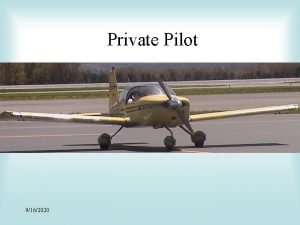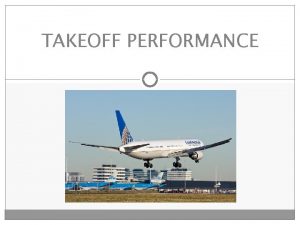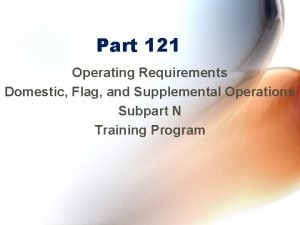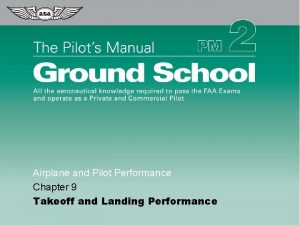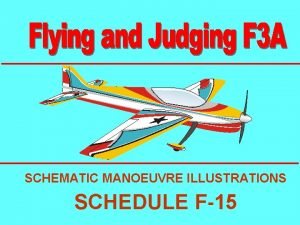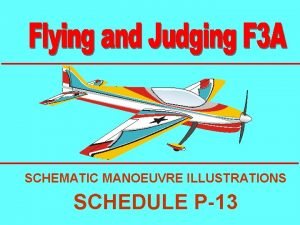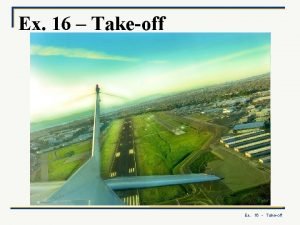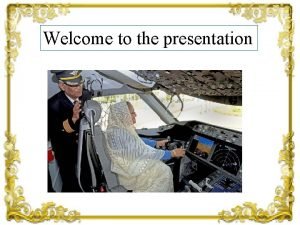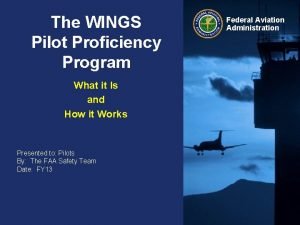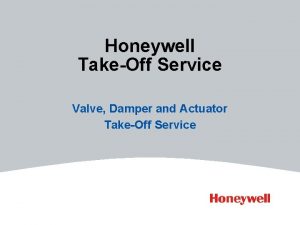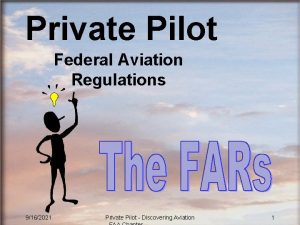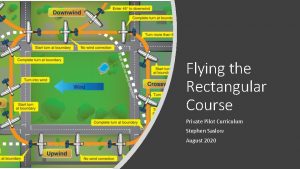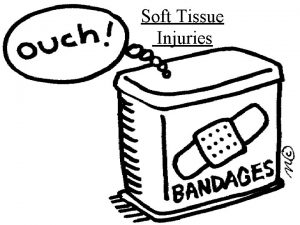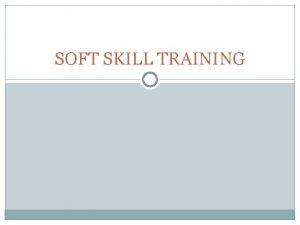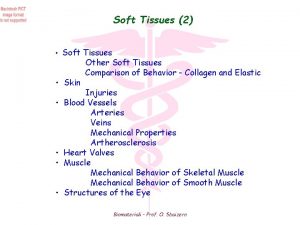Soft Field Takeoff Private Pilot Curriculum Stephen Saslow

























- Slides: 25

Soft Field Takeoff Private Pilot Curriculum Stephen Saslow August 2020

Objective The student should develop the understanding of the softfield takeoff as well as the skills needed to perform the takeoff from a soft-field. The student should be able to demonstrate the soft-field takeoff to ACS/PTS standards.

Elements of Soft Field Takeoff • Overview • Taxi • Takeoff Roll • Lift-Off • Initial Climb KEY ELEMENTS • Constant back pressure • Transfer weight from the wheels to the wings • Stay in ground effect until reaching Vy or Vx

What are Soft Field Takeoffs, Why Do We Learn Them? A takeoff from a “soft” field. Just like it says in the name, we are attempting to takeoff from a soft, often uneven surface which could produce enough drag to prevent the airplane from reaching normal takeoff speeds. Soft surfaces or long wet grass can reduce the aircraft's acceleration so much during the takeoff roll that adequate takeoff speed might not be attained if normal takeoff techniques were employed. As a maneuver, this will greatly improve takeoffs, landings, and overall aircraft control.

Differences from a Normal Takeoff: • Hazards • Reduced ability to accelerate How To Perform a Soft Field Takeoff • Taking off from a soft surface (sand, tall grass, snow, dirt, mud, etc. ) reduces the airplane’s ability to accelerate during the takeoff roll and may prevent the airplane from reaching adequate takeoff speed using normal takeoff techniques • Potentially hazardous terrain • Even if the airplane could accelerate to takeoff speed on the soft-field, the high speed over rough, uneven terrain presents its own challenges • Damage to the gear • Debris as well as the high stress associated with uneven terrain • Damage to the flaps (more applicable to a low wing airplane) • The longer the airplane stays on the ground, the more debris is thrown toward the flaps • Cartwheeling or flipping • If the nosewheel hit a hole during the takeoff run the results could be catastrophic, especially at high speeds

Differences from a Normal Takeoff: (continued) How To Perform a Soft Field Takeoff • To minimize these hazards, the goal of a softfield takeoff is to get off the ground as quickly as possible, and accelerate to a safe climb speed while in ground effect • Accomplished by establishing a relatively high angle of attack as early as possible • Once airborne, staying in ground effect requires a feel for the plane and fine control touch • Too much forward pressure could lead to ground contact • Not enough forward pressure could result in climbing out of ground effect at too low of an airspeed

How To Perform a Soft Field Takeoff The Basics • Maintain back pressure • Keep as much weight as possible off the nose to prevent it from getting stuck, or digging in • Maintain back pressure during the taxi and takeoff roll • Keep the aircraft moving • Stopping on a soft surface might bog the airplane down or get it completely stuck • The pilot should maintain continuous motion with sufficient power while lining up for the takeoff roll • Do a wheelie down the runway • Establish and maintain a relatively high angle of attack or nose-high pitch as early as possible • The nose will leave the ground prior to the main wheels. Adjust back pressure to keep the nose off the ground • Transfer the airplane’s weight rapidly as possible from the wheels to the wings • Accelerate in ground effect until reaching climb speed • The airplane will become airborne prior to normal rotation speed, and well before a safe climb speed • Do not attempt to climb out of ground effect before reaching a safe climb speed (VX or VY) • May result in the airplane settling back onto the surface, not being able to climb further even with full power, or a stall

Runway Incursion Avoidance Controlled Airport (Unlikely to be soft field and controlled) • Request and receive the appropriate clearance to taxi • Request and receive the appropriate clearance before crossing any hold short bars onto a runway • Have a taxi diagram available for use • In the case of confusion, query the controller • Stop the airplane, if necessary, to prevent an incursion Uncontrolled Airport • Announce intentions on the CTAF when taxiing to alert other aircraft of your position and intentions • Use the other aircraft’s radio calls to build a mental picture of the traffic in the area and how they may affect you • Check Final Approach • Before taxiing onto the runway, ensure you have time to takeoff before any aircraft make the turn onto final • As a general rule, don’t take the runway with another airplane on final • A 360 degree turn on the ground in the direction of the traffic pattern is recommended to check for traffic at uncontrolled fields • Check the Runway • Before taxiing out, ensure the runway is clear of other aircraft, vehicles, persons, or other hazards • Common Error - Improper runway incursion avoidance

Properly Configure the Airplane Pre-takeoff Cessna 172 S calls for: • Wing Flaps 10 degrees

Soft Field Takeoff - Taxi Procedures • Keep the elevator fully aft for the entire taxi • This keeps as much weight as possible off the main wheel keeping it from getting stuck or bogged down • More power is necessary due to the increased ground friction/drag • This also increases control effectiveness due to larger displacement of air • Keep turns shallow and DO NOT STOP unless unsafe to continue • Stopping on a soft surface, such as mud or snow, might bog the airplane down; therefore, it should be kept in continuous motion with sufficient power while lining up for the takeoff roll • Airport Procedures • Assuming an uncontrolled field, make normal traffic calls when taxiing to alert other aircraft of your position and intentions • Use the other aircraft’s radio calls to build a mental picture of the traffic in the area and how they may affect you • If at a controlled airport, follow the tower’s instructions • Before taxiing onto the runway visually clear the area • Check the final approach and the rest of runway for traffic, or obstructions • Never taxi out with another plane on final approach • Since soft-field airports can be far from civilization and minimally maintained, be aware of any debris, animals, etc. that may have ended up on the runway prior to attempting takeoff • Common Error - Improper runway incursion avoidance procedures

Takeoff Roll • Continue to maintain back elevator pressure and movement • Don’t let the nose wheel settle or the aircraft come to a stop • Apply crosswind corrections (the same as a normal takeoff) • Full aileron into the wind at the beginning of the takeoff roll

• While aligning the aircraft with the takeoff path, takeoff power is accelerated smoothly and rapidly Takeoff Roll (continued) • Don’t stop to align the aircraft with the center of the runway • Apply right rudder to counteract the left turning tendencies • Even with all the distractions/different procedures associated with a soft-field, don’t forget to check the engine/instruments • “Gauges green, ” “Airspeed alive” • Anticipate a slow acceleration due to the additional drag associated with a softfield • Common Error – Improper use of controls during a short-field takeoff • Use proactive rudder pressure to counteract the yawing forces and keep the airplane moving straight down the center of the runway • Adjust aileron input in order to maintain crosswind corrections • As the airplane accelerates and the controls become more effective, reduce the aileron being held into the wind

• Back elevator pressure is initially held full aft • As the plane accelerates and the nose lifts off the ground the elevator pressure is relaxed gradually during the takeoff roll keeping the nose off the ground Takeoff Roll (continued) • • • Maintaining full back pressure during acceleration would result in the tail striking the ground Site Picture: The cowling should be on the horizon • Approximately 5 -6 degrees of pitch Use rudders to control direction during the ground roll • Ailerons should be used to maintain crosswind correction With the nose-high attitude throughout the takeoff run, the wings will increasingly relieve the wheels of the airplane’s weight as speed increases and lift develops, minimizing the drag caused by the soft-field surface When the attitude is properly maintained, the airplane will effectively fly itself off the ground at a speed slower than the normal rotation speed Common Error – Improper use of controls during a soft-field takeoff • As speed increases, back pressure must be reduced to avoid an excessive angle of attack • Too much back pressure can increase drag or drag the tail • Use rudder and aileron in coordination to maintain the enter of the runway and counteract any crosswind

Lift-off After the airplane initially becomes airborne, the nose should be lowered gently with the wheels clear of the surface to allow the airplane to accelerate to VX or VY in ground effect • Accelerate to VY for a normal climb, VX if an obstacle must be cleared • Remain within ½ wing span of the ground (ground effect is most effective here) • Common Error – Improper lift-off procedures • • Smoothly apply forward pressure to keep the aircraft close to the ground Abrupt/excessive control movements could easily put the aircraft back into the ground (possibly nose first)

Site Picture: The nose will need to point down, toward the runway, to stay in ground effect as airspeed and lift increase • Forward pressure is required to stay in ground effect Lift-off (continued) • As the airplane accelerates the wings generate more lift. Increasing forward pressure is required to remain in ground effect until the proper climb speed is reached • Forward pressure in combination with the nose pointing down while close to the ground can be VERY uncomfortable, especially to a new pilot • But it is necessary to stay in ground effect until the appropriate speed is reached

The airplane must remain in ground effect until at least Vx is reached Lift-off (continued) • Common Error – Improper lift-off procedures • Remain in ground effect, and do not attempt to climb out of ground effect until reaching a safe climb airspeed • May result in the airplane settling back onto the surface, not being able to climb further even with full power, or a stall

After a positive rate of climb is established (5), and the airplane has accelerated to VX or VY climb out as normal Initial Climb • Retract the gear and flaps as normal • Soft field runways are often short field runways (VX may be necessary more often than not) • If climbing out to avoid an obstacle, the climb out is performed at VX until the obstacle is cleared • After clearing the obstacle, the pitch attitude is adjusted to VY and the power may be set to the normal climb setting • Retract the gear and flaps as appropriate for obstacle clearance and performance

Initial Climb (Continued) • If departing from a wet/slushy airstrip, the gear should not be retracted immediately, allowing it to air dry • If cold, cycle multiple times to avoid freezing • If departing from a wet/slushy airstrip with an obstacle to clear, retract the gear when a positive rate of climb is established to achieve the desired performance, if required by the manufacturer’s guidelines • If necessary to prevent freezing, lower and/or cycle the gear once clear of the obstacle • Follow the manufacturer’s guidelines in the POH • Common Error - Improper climb attitude, power setting, or airspeed (VX or VY) • Set the pitch attitude for the airspeed desired (VX or VY) • Leave max power (takeoff power)

Initial Climb (Continued) Climb Checklist • Common Error - Improper use of checklists • Be sure the airplane is properly configured for the climb • The non-standard procedures associated with a soft-field takeoff could distract the pilot leading to missed steps. Always back yourself up with the checklist!

Soft Field Takeoff Procedures – Cessna 172 S • • • Do not stop on the runway, unless safety hazard exists Wing flaps – 10 degrees Apply full elevator back pressure Avoid using brakes, shallow turns Gently apply full throttle Adjust elevator back pressure to keep nose off runway Elevator Control – Nose high, but do not tail strike Lift off into ground effect as soon as possible Level off in ground effect and accelerate to Vx Climb at Vx (62 KIAS) until Obstacles Cleared Continue Climb at Vy • Wing Flaps Retract Slowly when airspeed is above 60 KIAS and obstacles cleared

Common Error • Improper runway incursion avoidance procedures • Improper use of controls during a soft-field takeoff • Improper lift-off procedures • Improper climb attitude, power setting, and airspeed (VX or VY) • Improper use of checklists

Soft Field Takeoff and the Senses Visually Hearing Feel • Takeoff roll site picture will have nose high • Lift-off Attitude will be slightly higher than Vy • Nose lowered after rotation to accelerate in ground effect • Soft fields can cause debris to be hitting the airplane • Right Rudder noticeably needed faster due nose wheel not resisting left turning – anticipate this • Remember what slow flight feels like, controls may be mushy on takeoff

Common Errors • Improper runway incursion avoidance procedures • Improper use of controls during a soft-field takeoff • Improper lift-off procedures • Improper climb attitude, power setting, and airspeed (VX or VY) • Improper use of checklists

Performing Soft Field Takeoffs Objective: To develop the understanding of the soft-field takeoff as well as the skills needed to perform the takeoff from a soft-field. The student should be able to demonstrate the soft-field takeoff to ACS/PTS standards. Purpose: Soft surfaces or long wet grass can reduce the aircraft's acceleration so much during the takeoff roll that adequate takeoff speed might not be attained if normal takeoff techniques were employed. As a maneuver, this will greatly your improve takeoffs, landings, and overall aircraft control. Private Pilot ACS Skills Standards 1. Complete the appropriate checklist. 2. Make radio calls as appropriate. 3. Verify assigned/correct runway. 4. Ascertain wind direction with or without visible wind direction indicators. 5. Position the flight controls for the existing wind conditions. 6. Clear the area, maintain necessary flight control inputs, taxi into takeoff position and align the airplane on the runway centerline without stopping, while advancing the throttle smoothly to takeoff power. 7. Confirm takeoff power and proper engine and flight instrument indications. 8. Establish and maintain a pitch attitude that will transfer the weight of the airplane from the wheels to the wings as rapidly as possible. 9. Lift off at the lowest possible airspeed and remain in ground effect while accelerating to VX or VY, as appropriate. 10. Establish a pitch attitude for VX or VY, as appropriate, and maintain selected airspeed +10/ -5 knots during the climb. 11. Configure the aircraft after a positive rate of climb has been verified or in accordance with aircraft manufacturer’s guidance. 12. Maintain VX or VY, as appropriate, +10/-5 knots to a safe maneuvering altitude. 13. Maintain directional control and proper wind drift correction throughout takeoff and climb. 14. Comply with noise abatement procedures. Commercial Pilot ACS Skills Standards 1 Complete the appropriate checklist. 2. Make radio calls as appropriate. 3. Verify assigned/correct runway. 4. Ascertain wind direction with or without visible wind direction indicators. 5. Position the flight controls for the existing wind conditions. 6. Clear the area, maintain necessary flight control inputs, taxi into takeoff position and align the airplane on the runway centerline without stopping, while advancing the throttle smoothly to takeoff power. 7. Confirm takeoff power and proper engine and flight instrument indications. 8. Establish and maintain a pitch attitude that will transfer the weight of the airplane from the wheels to the wings as rapidly as possible. 9. Lift off at the lowest possible airspeed and remain in ground effect while accelerating to VX or VY, as appropriate. 10. Establish a pitch attitude for VX or VY, as appropriate, and maintain selected airspeed ± 5 knots during the climb. 11. Configure the airplane after a positive rate of climb has been verified or in accordance with aircraft manufacturer’s guidance. 12. Maintain VX or VY, as appropriate, ± 5 knots to a safe maneuvering altitude. 13. Maintain directional control and proper wind-drift correction throughout takeoff and climb. 14. Comply with noise abatement procedures.

Soft Field Takeoff: Conclusion Anytime we are taking off from a soft field runway we need to get the weight off the wheels and onto the wings of the airplane as quickly as possible. This reduces the drag associated with a soft-field and allows the airplane to accelerate to a safe speed before climbing out. Without these procedures it is very possible the airplane would never reach the speed required for takeoff.
 What exception if any permits a private pilot
What exception if any permits a private pilot Gross takeoff weight
Gross takeoff weight Part 121 pic requirements
Part 121 pic requirements Minimum enroute altitude
Minimum enroute altitude Airplane landing distance graph
Airplane landing distance graph F-15 schematic
F-15 schematic Mode of measurement for excavation
Mode of measurement for excavation Pull push takeoff
Pull push takeoff Opencore takeoff delay
Opencore takeoff delay Cnaf 3710 weather minimums
Cnaf 3710 weather minimums Koch chart density altitude
Koch chart density altitude Wins soft innovations private limited
Wins soft innovations private limited Magnitude of magnetic force
Magnitude of magnetic force Individual differences in second language learning
Individual differences in second language learning Field dependent vs field independent
Field dependent vs field independent Q factor of capacitor
Q factor of capacitor E field h field
E field h field Data types and field properties
Data types and field properties Field dependent and field independent
Field dependent and field independent Magnetic field
Magnetic field Md mizanur rahman pilot
Md mizanur rahman pilot The wings pilot proficiency program is based on
The wings pilot proficiency program is based on Kilanga pilot
Kilanga pilot Direct changeover
Direct changeover Direct conversion system
Direct conversion system Plural of pilot
Plural of pilot
